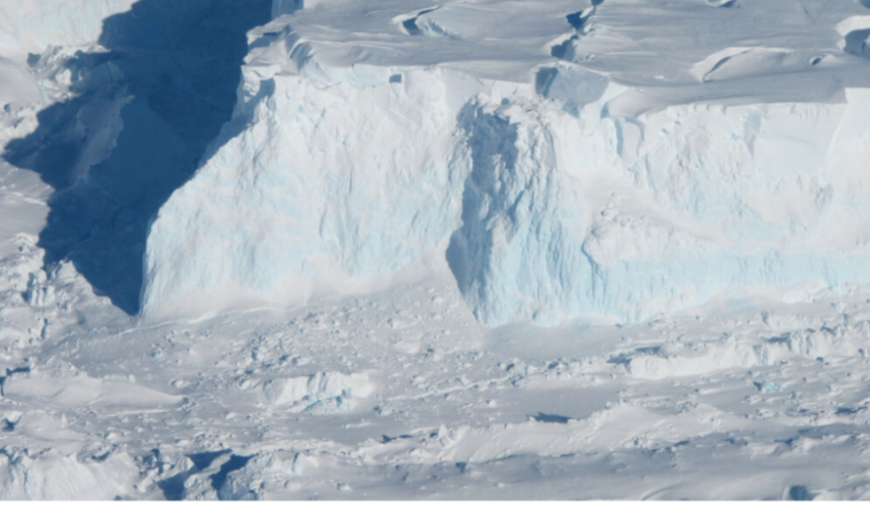Thwaites Glacier is a Florida sized slab of ice in Antarctica. This glacier is sliding into the ocean and poses the greatest near term threat to sea level rise, scientists say. New data suggest that an ice shelf slowing the glacier’s slide may collapse within five years.
Thwaites Glacier, also known as the Doomsday Glacier, is an unusually broad and vast Antarctic glacier flowing into Pine Island Bay, part of the Amundsen Sea, east of Mount Murphy, on the Walgreen Coast of Marie Byrd Land. Its surface speeds exceed 2 kilometres (1.2 miles) per year near its grounding line. Its fastest flowing grounded ice is centered between 50 and 100 kilometres (31 and 62 miles) east of Mount Murphy. In 1967, the Advisory Committee on Antarctic Names named the glacier after Fredrik T. Thwaites (1883 to 1961), a glacial geologist, geomorphologist and professor emeritus at the University of Wisconsin–Madison.The historian Reuben Gold Thwaites was his father.
Thwaites Glacier is closely monitored for its potential to raise sea levels. Along with the Pine Island Glacier, it has been described as part of the “weak underbelly” of the West Antarctic Ice Sheet, because of its apparent vulnerability to significant retreat. This hypothesis is based on both theoretical studies of the stability of marine ice sheets and observations of large changes on these two glaciers. In recent years, the flow of both of these glaciers has accelerated, their surfaces have lowered, and their grounding lines have retreated.
The Thwaites Ice Shelf, a floating ice shelf which braces and restrains the eastern portion of Thwaites Glacier, is likely to collapse within a decade from 2021, leading to increased outflow and contribution to sea level. For this reason, Thwaites Glacier and its ice shelf have been proposed as sites for climate engineering interventions to stabilize and preserve its ice.
Thwaites Ice Shelf (75°6′S 105°31′W), is an Antarctic ice shelf in the Amundsen Sea. It was named by ACAN after Fredrik T. Thwaites, a glacial geologist and geomorphologist. The Thwaites Ice Shelf is one of the biggest ice shelves in West Antarctica, though it is highly unstable and disintegrating rapidly. Since the 1980s, the Thwaites glacier, nicknamed the “Doomsday glacier”, has had a net loss of over 600 billion tons of ice, though pinning of the Thwaites Ice Shelf has served to slow the process. The Thwaites Ice Shelf has acted like a dam for the eastern portion of glacier, bracing it and allowing for a slow melt rate, in contrast to the undefended western portion.
According to the American Geophysical Union in a 2021 study, the Thwaites Eastern Ice Shelf (TEIS) buttresses one-third of Thwaites glacier. Removal of the shelf has the potential to increase the contribution of Thwaites glacier to sea level rise by up to 25%. Recent research shows that the ice shelf is losing its grip on a submarine shoal that acts as a pinning point and the shear margin that separates the Thwaites Eastern Ice Shelf from the Thwaites glacier Tongue has extended, further weakening the ice shelf connection to the pinning point. A sequence of Sentinel-1 radar imagery shows that parallel wing and comb cracks have recently formed rifts at high angles to the main shear margin and are propagating into the central part of the ice shelf at rates as high as 2km per year. Satellite data, ground-penetrating radar, and GPS measurements indicate that collapse of the ice shelf may be initiated by intersection of rifts with hidden basal crevasse zones within as little as 5 years.
Complete melting of Thwaites glacier is predicted to increase global sea levels by 65 cm (2.13 ft) according to the European Geosciences Union, and the Cooperative Institute for Research in Environmental Sciences states that the collapse of Thwaites glacier could ultimately lead to sea-level rise of up to 3 meters. if it draws the Pine Island and surrounding glaciers with it, due to marine ice sheet instability.

